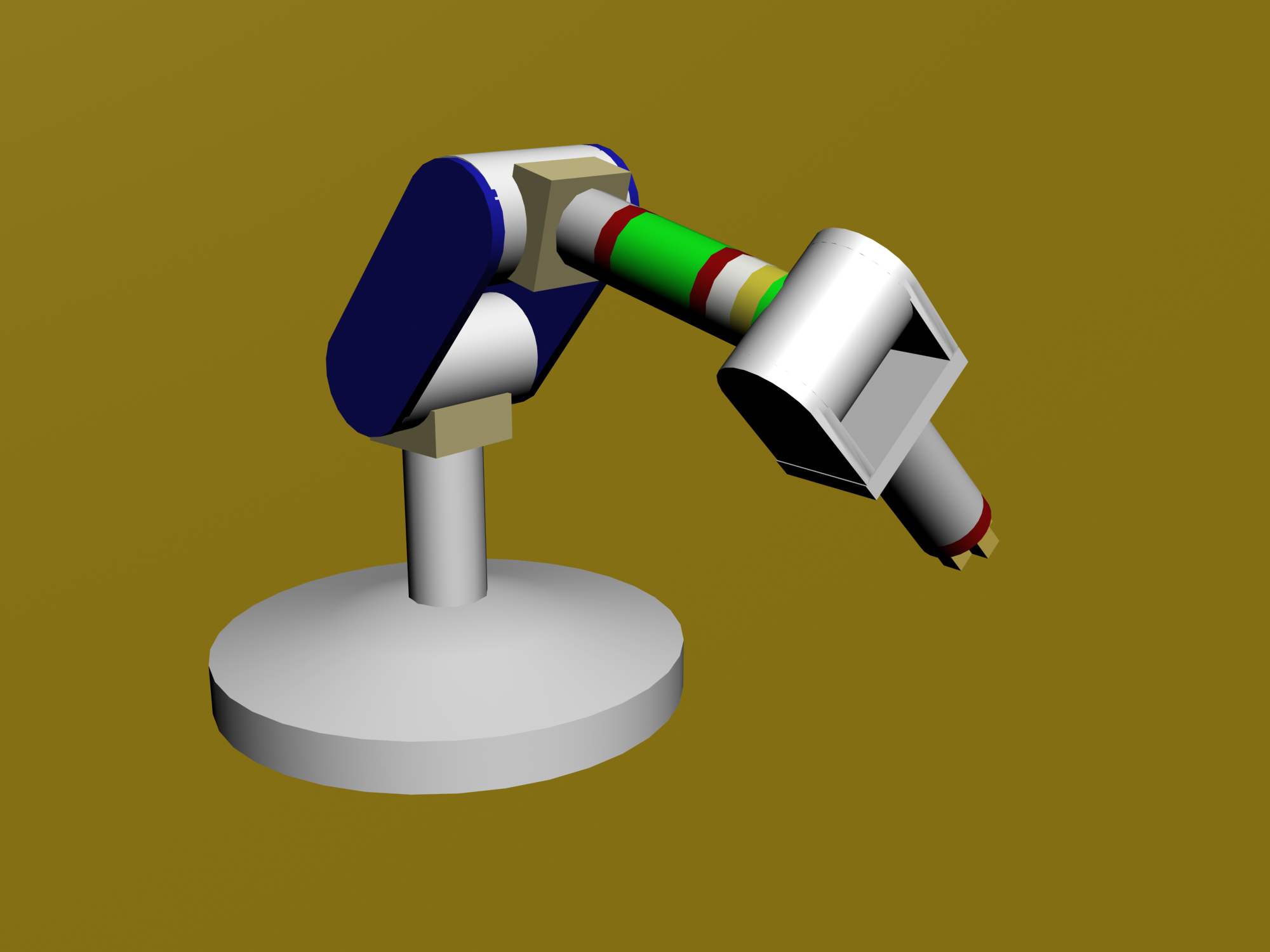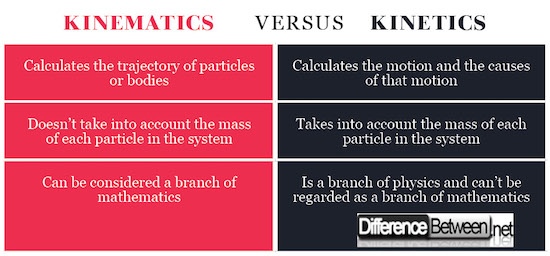Difference Between Kinetics and Kinematics
Both kinetics and kinematics are branches of classical physics, but the very fact that they have different names clearly implies that they describe two different things.
Kinematics is a branch that focuses on describing the motion of bodies, so it mainly deals with calculating velocities and accelerations over time for various points, bodies, or systems of bodies.
In comparison, kinetics additionally deals with where those velocities and accelerations are coming from, meaning different forces or torques that are applied to those points, bodies, or systems of bodies.
Another important difference is whether mass is considered. Namely, kinematics doesn’t take into account the mass of each body, but rather just calculates their position over time, whereas kinetics also takes into account varying masses of bodies. This difference partially stems from the previous one, because calculating the impact of different masses on the movement of these bodies is in its essence really a calculation of the gravitational force acting upon those bodies, and since kinetics deals with forces and kinematics doesn’t, consequentially kinematics won’t take into account different masses and kinetics will.
What is Kinematics?
As mentioned above, kinematics is a branch of classical mechanics, an area of physics that describes the world at the scale we’re all familiar with – for example, how cars move, how thrown balls fly, etc.
The fundamental law on which the whole area was built is the famous Newton’s second law of motion, which states that the force is equal to mass times the acceleration. However, kinematics doesn’t calculate any forces that cause those accelerations to appear.
Instead, it only focuses on the velocities, accelerations and positions of objects. Due to its exclusive focus on position, it is sometimes referred to as the “geometry of motion” among the scientific community, and can arguably be looked at as just another branch of mathematics.
The problems that kinematics is built to solve usually include having a given set of particles, bodies or systems of bodies with known initial positions, velocities and accelerations. Given the geometry of the space they move in, using the methodology kinematics gives, you can calculate how each of those bodies will move, if no other force acts upon these objects.
In addition, kinematics doesn’t take into account the masses of the objects in the system, because that would indirectly mean it would calculate the effects of the gravitational force, which it was not built to calculate. Therefore, it only focuses on the movement, given their initial conditions and the geometry of the terrain.
What is Kinetics?
Kinetics is another branch of classical mechanics, albeit a lot more connected to the fundamental law of classical mechanics that was mentioned above – Newton’s second law. This is because it takes into account the causes for different motions of bodies, which can be forces or torques, in case of the rotational motion. Kinetics is actually an older term that was used before the 20th century to describe this area of physics. Later it was decided that the term sounds too similar to kinematics and the term dynamics was introduced for the same purpose. However, the term kinetics wasn’t completely rejected, and is still used sometimes to describe this area of physics. Both the terms kinetics and dynamics describe the same area of physics though, so there’s no ambiguity present in those terms.
Difference Between Kinetics and Kinematics
Causes of motion in Kinetics and Kinematics
This is the main and most notable difference between these two areas. While kinematics only focuses on the position, speed and acceleration of the system it describes, kinetics, or dynamics, as it’s better known today, takes into account the causes for these motions which can be different forces or torques.
Inclusion of particle mass in Kinetics and Kinematics
Since kinematics forsakes the effects of different forces, that also includes the gravitational force, both between the bodies in the system and between each particular body and a potential gravitational field in which all of the motion takes place. Consequentially, kinematics also doesn’t take into account the masses of the particles or bodies in the system it describes, while kinetics does, which is the second big difference between the two areas.
Physics or mathematics of Kinetics and Kinematics
Finally, another difference can be spotted in the question of whether kinematics can really be considered a branch of physics. Of course, officially, it is, but you’ll see many experts refer to it as a branch of mathematics, mainly because it forsakes one of the most fundamental phenomena in all of physics – forces, so they refer to it as “geometry of motion” and consider it just another branch of mathematics that only calculates the change of different variables in different functions, without any respect and connection to the real world.
Kinematics vs. Kinetics : Comparison Table
Summary of Kinetics vs. Kinematics
- Kinetics and kinematics are both branches of classical physics, an area that has Newton’s second law of motion as its fundamental law
- Both areas describe the motion of point particles, bodies or systems of bodies in different spaces and terrains
- Kinematics doesn’t take into account the causes for such motion, though, and only calculates their trajectories, velocities and accelerations
- Kinetics, on the other hand, takes into account all the causes of motion, including forces and torques, in case of rotational motion
- Kinematics consequentially doesn’t take into account the mass of each particle in the system, whereas kinetics does
- Difference Between Kinetics and Kinematics - March 16, 2018
- Difference Between Correlation and Association - March 13, 2018
- Difference Between Momentum and Impulse - March 8, 2018
Search DifferenceBetween.net :
1 Comment
Leave a Response
References :
[0]Paul, Burton. Kinematics and dynamics of planar machinery. prentice Hall, 1979.
[1]Wilson, Charles E., and J. Peter Sadler. Kinematics and dynamics of machinery. Prentice Hall, 2003.
[2]Synge, John L. "Classical dynamics." Principles of Classical Mechanics and Field Theory/Prinzipien der Klassischen Mechanik und Feldtheorie. Springer Berlin Heidelberg, 1960. 1-225.
[3]Image credit: https://en.wikipedia.org/wiki/Forward_kinematics#/media/File:Robot_arm_model_1.png
[4]Image credit: https://en.wikipedia.org/wiki/Inelastic_collision#/media/File:Bouncing_ball_strobe_edit.jpg




This blog is perfectly explain the two similar looking concepts but not actually.
Great job..